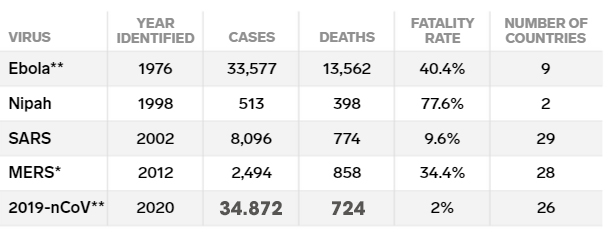Experts say: The death rate of corona virus infection may decrease
- Tram Ho
The number of deaths in the new respiratory infection caused by the new corona virus (2019-nCoV) in China is about to exceed the SARS epidemic 17 years ago. During the first pandemic of the 21st century, SARS spread to 29 countries, leaving more than 8,000 people infected and 774 of them dead.
As of the morning of 8/2, the new corona virus has also infected nearly 35,000 people in 28 countries and territories, killing 724 of them.
* Please read here to update the latest data and information about the disease caused by corona virus worldwide.
However, the new virus strain seems to be less dangerous than SARS. While the acute respiratory tract syndrome SARS can kill 10 out of every 100 people infected, with a mortality rate of 9.6%, the World Health Organization (WHO) says children. The average of 2019-nCoV is only 2%.

** Data updated until February 8, 2020
Even, the actual death rate due to the new corona virus is expected to be even lower than this 2%, if the cases are mild or no symptoms are fully reported.
Last week, the New York Times reported that doctors who were on duty in the Wuhan epidemic center were short of test kits, leading to delayed diagnosis.
Once a person has been sampled for testing, it may take about one to two days for the results to return. Combined with many factors, this has created a delay in the diagnostic figures for infected people.
” I guess there is a lag in a lot of reports [so far], ” said Aaron Milstone, an epidemiologist at Johns Hopkins University. ” If there are people who are ill and they are not tested, then we obviously do not know them .”
The actual death rate may be lower
While the World Health Organization says the average death rate for a new corona virus infection is 2%, this number may vary depending on how you slice the problem. For example, most cases of the current corona virus infection have been reported in Hubei province, where the Wuhan epidemic is concerned.
If we divide the number of deaths in Hubei province alone by the number of cases here, the percentage is somewhat higher than the average, about 2.8%. Continue to narrow down the Wuhan epidemic, the number increased even more, to about 4.1%.
A study in the Lancet Medical Journal further narrowed the scope, down to 99 patients infected with the corona virus around Huan Nam Seafood Market, the site believed to be the first source of the pathogen spreading from animals to humans. . These people have mortality rates up to 11%.
But the higher the number, the closer it is to the center of translation, which means it will be lower on the outer edge. At present, excluding Hubei Province, only 25 deaths have been reported across the rest of mainland China, out of 9,616 cases. The death rate now is only 0.26%.
But there are still many unknowns: Currently more than 1,500 patients infected with corona virus have been confirmed to be recovering. That means the fate of the remaining 33,000 is uncertain.
Viruses are also continuing to spread. A peer-reviewed study published in the Lancet Medical Journal recently estimated that an average infected person can spread the virus to 2-3 others. That means the infected population could double every 6.4 days.
But of course, not all infected patients will die. In fact, some health experts predict that mortality may decline as the number of cases increases.
According to Anthony Fauci, director of the US National Institute of Allergy and Infectious Diseases, the cases reported right now are mostly those who come to the hospital with serious symptoms.
” There is another group of people infected with the virus that have absolutely no or no symptoms at all,” Fauci said at a brief meeting in the Journal of the American Medical Association. “We will then see a downward trend in overall mortality.”
It is more like an influenza pandemic than SARS
Estimates of the new incubation period of the new corona virus suggest that it can last up to 14 days. Patients infected with the virus often have a fever and have breathing problems such as coughing or difficulty breathing. Current tests can only identify corona virus when a patient has symptoms.
” We saw people carrying detectable viral loads, then they were negative for the virus again and then after three days the virus was found again, ” said Robert Redfield, director of the Centers for Control and Prevention. US epidemic (CDC), said in a brief meeting last week. ” We don’t know the nature of how this virus is released.”
* Readers want to understand the true nature of the new strain of corona virus (2019-nCoV), please refer to the article of Doctor Tran Van Phuc here.
To date, most of the deceased are elderly patients or people with preexisting health problems. A recent study in the journal JAMA showed that the average age of patients with new coronary virus infection is from 49 to 56 years old. But Chinese authorities have reported that 80% of cases in China are among those 60 or older.
WHO reports that 14% of reported cases in China are “serious” cases.
A study published in the New England Journal of Medicine in January also speculated that ” children may be less likely to be infected or if they may have milder symptoms” than adults. . Despite this, the WHO says we are not subjective, every population group is at risk of infection:
Fauci said the new corona virus may look more like an influenza pandemic than SARS, based on its mortality rate. SARS and the new corona virus only share about 80% of their genetic code, but the corona virus family has four other strains that cause only the common cold.
Back in the Spanish flu pandemic of 1918, its death rate was similar to that of the corona virus at this time. But other later pandemics had lower mortality rates, Fauci said, that number ranged from 0.8% to 1.2%.
The annual seasonal flu epidemic in the US has a mortality rate of about 0.1%. This year’s flu season is even better controlled, with mortality rates falling to just half. CDC reports that only 0.05% of seasonal flu patients die.
So what does the future of the new corona virus statistics look like? David Weber, a professor of epidemiology at the University of North Carolina, said: ” The infections and deaths we are seeing now reflect those who started getting sick a week ago. So, t I guess everything will change over time . ”
Source : Genk

